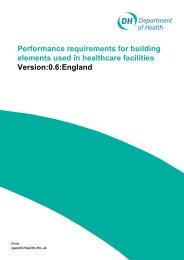Early Life Nutrition and Lifelong Health - Derbyshire Local Medical ...
Early Life Nutrition and Lifelong Health - Derbyshire Local Medical ...
Early Life Nutrition and Lifelong Health - Derbyshire Local Medical ...
You also want an ePaper? Increase the reach of your titles
YUMPU automatically turns print PDFs into web optimized ePapers that Google loves.
BMA Board of ScienceThe case for breastfeedingAll current guidelines, including those from the Department of <strong>Health</strong> (DH), recommend exclusivebreastfeeding for newborns <strong>and</strong> for the first six months of infancy. Breast milk provides all thenutrients required at this age in a form that is hygienic <strong>and</strong> easy to digest. The protein,carbohydrate <strong>and</strong> fat profiles are unique to breast milk <strong>and</strong> differ in many ways from other animalmilks. 126 Breast milk also contains a range of bioactive components, including anti-microbial <strong>and</strong>anti-inflammatory factors, digestive enzymes, hormones <strong>and</strong> growth factors. 126, 127 Anti-microbialagents include leucocytes, secretory immunoglobulin (Ig)A, IgM <strong>and</strong> IgG antibodies, oligosaccharides,lysozyme, lactoferrin, lipids, fatty acids <strong>and</strong> mucins. Growth factors are thought to be importantfor gut maturation. Lactoferrin is one of several specific binders in human milk that greatly increasethe bioavailability of micronutrients.Key messageAll current guidelines, including those from DH, recommend exclusive breastfeeding for thefirst six months after birth.The volume <strong>and</strong> composition of breast milk vary with the stage of lactation, within each individualfeed, <strong>and</strong> with maternal nutritional status. 126 Recent research in animals has shown that reducedfetal growth caused by placental insufficiency can impair the quality <strong>and</strong> quantity of breast milk. 128Colostrum, produced during the first few days is low in volume <strong>and</strong> nutrient content but high inanti-microbial factors. Volume <strong>and</strong> nutrient content reach a peak, in mature breast milk, severalweeks after birth. The mother’s macronutrient intakes do not have much influence on milkcomposition, but her diet does affect the long-chain fatty acid <strong>and</strong> vitamin content of her milk.Breastfed infants have more control over the flow of milk than bottle-fed infants. Breastfeeding istherefore often described as an ideal ‘supply <strong>and</strong> dem<strong>and</strong>’ regulation system. The feedingbehaviour of the baby <strong>and</strong> the quality of the breast milk change with time in a way that mayprevent overfeeding, teach the infant how to recognise satiety signals, <strong>and</strong> regulate energy intakedifferently from formula-fed infants.The role of leptin in breast milk may be of particular importance in the early development of bothadipose tissue <strong>and</strong> appetite regulatory systems in the infant, <strong>and</strong> ultimately on propensity toobesity in later life. A recent study showed that administration of physiological levels of leptin tosuckling rats caused a significantly lower body weight in adulthood. 129 Observational studies haveshown that breastfeeding is associated with lower rates of childhood obesity. 130 Bearing in mindthe absence of leptin in formula milk, this may have important implications for the prevention ofobesity in children <strong>and</strong> in adults.26<strong>Early</strong> life nutrition <strong>and</strong> lifelong health



